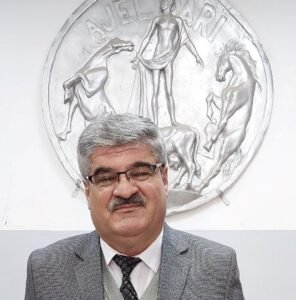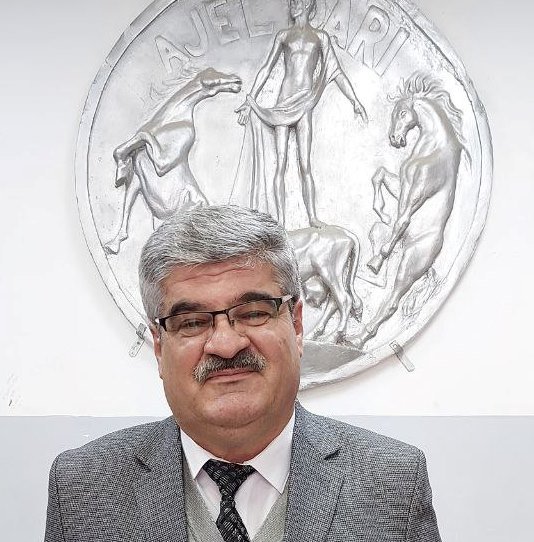Common diseases between humans and animals ( Zoonoses )
Common diseases between humans and animals ( Zoonoses )

Dr. Fridun Abdulstar / Professor of Sulaimani University
On the occasion of World Common Diseases Day, human diseases between animals and humans
According to the United Nations, the world’s population has reached eight billion people, and human needs are also increasing in all aspects, especially food needs of animal products, poultry, red and white meat and eggs, which are considered the main source of protein. Therefore, nowadays, to meet human nutritional needs, animals are generally raised on a wider scale and their numbers are increased to use rapid solutions through new technologies and by industrializing the production process.
Such as poultry breeding industry, dairy and beef cow breeding industry, sheep and goat breeding industry, as well as yogurt, cheese and butter production industry, etc. Of course, this has led to further development of trade activities between countries through various means of transportation, this extensive exchange, animals and birds between countries makes the number of animal diseases increase annually, resulting in increased threat to human health. This is because medically, humans, animals and birds, in a way their health levels have a direct impact on each other, of course through a number of common diseases called Zoonoses .
In the late 20th and early 20th centuries, a number of common diseases، Zoonoses ، emerged and spread to countries, including bird flu, swine flu, mad cow, Ebola, coronavirus and monkey disease, which have left a negative impact on all aspects of life. That is, in addition to health, economic, political and international relations.
According to research, some Zoonoses diseases have been recorded in Kurdish villages and cities, including Malta fever, feline fever, diphtheria, Newcastle disease, dengue fever, and other diseases that pose a serious threat to the health and economy of Kurdish citizens.
The idea of one health and one medicine
According to historical sources, the idea of one health and one medicine has been the philosophical principle that physicians have generally worked on throughout history. Hippocrates 460-377 BC Greek philosopher and physician, known historically as the father of medicine, played a major role in laying the basic principles of the philosophy of human medicine and veterinary medicine. Research and study of veterinary medicine has been a means of understanding human medicine since the time of Greece, under the leadership of the ancient Greek medical leaders Hebucrates and Aristotle. One of the major works of the great Greek philosopher Aristotle (384-322 BC). He conducted practical experiments on the bodies of dead animals to learn about the shape and structure of their organs and how they worked and compared them. This was a good way to understand the shape and structure of human body parts The idea of studying dead people became the basis of comparative medicine. Leonardo Da Vinci (1452-1519) was an Italian thinker, artist and scientist. He was one of the leaders of the Renaissance. He made a unique contribution to veterinary medicine and human medicine by analyzing the bodies of dead animals and humans The purpose of drawing the outline of their limbs and the skeleton of their bones. Da Vinci is considered the father of research science in history.
From the perspective of one medicine and one health in this era, all surgeries and experiments that are performed for the first time in humans are initially tested on animals. Azad Najjar, the inventor of the artificial heart in humans and the world for the first time tested the artificial heart on monkeys and achieved success. Azad has visited the slaughterhouse in his hometown in Sweden to see and study the hearts of cows, sheep, goats and pigs to understand the physiology of animal hearts and compare them with human hearts.
What does human disease mean?
Animal diseases or common diseases between humans, animals and birds, in Arabic sources are called (common diseases between humans and animals) and in medical sources are generally called (zoonoses). It is considered a major branch of medical science in colleges and institutes of veterinary medicine and human medicine is given great importance nowadays in all countries of the world.
According to medical research, the scientific term (zoonoses); consists of two Greek words, the first (zoo) means animals or living things. The second is nosos or noson, which means disease. Another opinion of experts interprets it as follows: (Zoo) refers to animals or living things, (noso) is a person who studies diseases (nosis). It means disease and generally means the study of diseases of animals and living things. In 1959, the World Health Organization defined communicable diseases as diseases that are naturally transmitted between wild animals and humans, including those transmitted directly or indirectly from animals and birds to humans, as well as those that were transmitted from humans Animals, and according to scientific sources, include diseases that affect animals and humans separately, such as foot and mouth disease in humans and ear infections in animals.
HIV is considered a human disease that was transmitted from animals to humans throughout the 20th century, although it is currently only found in humans.
The use of the term zoonoses dates back to 1855, according to historical sources. Therefore, the term zoonoses was first used by Rudolph Virchow in his Hand Book of Communicable Diseases, which has been used continuously in medical sources ever since.
World Human Diseases Day
According to international statistics, about 2.7 million people die annually due to animal diseases, so health and veterinary centers, July 6 has been designated as World Animal Diseases Day, of course, in order to remind, raise awareness and educate the world’s population About the causes, types, symptoms, treatment and prevention of diseases.
According to sources, the designation of July 6 every year is due to the successful attempt of the famous French scientist Louis Pasteur on July 6, 1885, who used the first vaccine against rabies for a young boy who was bitten by a rabid dog According to the statistics of health centers, 75% of the diseases that affect humans nowadays are caused by animals and birds. Therefore, the commemoration of World Animal Diseases Day on July 6 every year encourages citizens to implement health and veterinary requirements in all parts of society. It also strengthens food safety laws to prevent foodborne disease transmission.
Causes of the increase in the number of human diseases
Experts attribute the increase in the number of human diseases in recent years to:
1. Changes in the Earth’s climate in general.
2. Increase the production of livestock and poultry products through new technologies.
3. Increase in the number of livestock and poultry in urban centers.
4. Increased trade in animals, especially wild animals.
5. Changes in the soil and climate of countries due to continuous human intervention, especially in the reduction of forest area and greenery.
6. Overuse of antibiotics among citizens, which causes germs to develop antimicrobial resistance.
7. Sometimes it is the result of scientific research of research centers in the world’s powerful countries for the sake of political competition and conflict.
According to Kate Jain, head of the Department of Environmental Sciences at the University of London, the increase in the spread of human diseases in recent years, due to environmental changes and human behavior, which causes deforestation and population growth. Of course, all these are the reasons for the closer contact between humans and domestic and wild animals and birds. Environmental reports indicate that climate change has caused mass migration of organisms to new, more suitable areas, and as a result, mixing and contact with other animals allows the spread and transmission of various disease causers.
How to prevent human diseases:
Every project to eradicate animal diseases in countries should start with animals, because unless the health of animals and birds is protected, human health cannot be protected.
1. There should be international coordination in order to develop a long-term project to reduce the threat of human diseases on the population of the earth, this will be done by the generation of international organizations on animal and human health and food Global Agriculture.
2. Establishment of the Center for Human Diseases in order to monitor and diagnose the diseases that exist in different parts of Kurdistan.
3. In the Ministry of Education, the subject of animal diseases should be included in the curriculum at different stages of education in order to familiarize students with the necessary and accurate information.
4. Establish several committees of doctors and staff from veterinary and health institutions to visit the villagers to explain the ways of transmission of animal diseases and their danger to human health and the environment, because the villagers are more related to animals and birds.
5. Disseminate scientific awareness about the threat of human diseases to human, animal and environmental health, in a simple manner through the media.
6. Breeders of various animals and birds in cities and villages should regularly contact veterinary clinics and veterinary hospitals, to obtain necessary information about how to raise animals and birds, as well as how to deal with sick animals.
7. Eradication of biological vectors such as flies, mosquitoes, ticks, horses, etc. Especially in summer, spring and autumn.
8. No animals or birds should be allowed to be brought to Kurdistan from the borders, especially from countries where the disease has already spread.
9. The municipalities should increase the green area in Kurdistan’s towns and villages and not allow any forests and gardens to be destroyed.
source
- World zoonose day 2023, date, theme, significance and history, Komal Jain 2023
- الامراض المشترکة بین الانسان و الحیوان، د.جلیلة مصطفی خلیل.
- نەخوشیە مروژەلییەکان، د.فریدون عەبدولستار، ٢٠٢١ ، سلیمانی، چاپی سێیەم.
- سمیناری داهێنەری کورد لە سوید بەرێض د. ئازاد نەجار لە سەروکایەتی زانکوی سلێمانی رێکەوتی ١٦/ ٢/ ٢٠٢١
- مێژوی پیشەی پزیشکی ڤێتێرنەری، چاپی دووەم، پروفیسور د. فریدون عەبدولستار، ٢٠٢٣
اختيار المحررش
أحدث فيديو
news via inbox
Nulla turp dis cursus. Integer liberos euismod pretium faucibua


